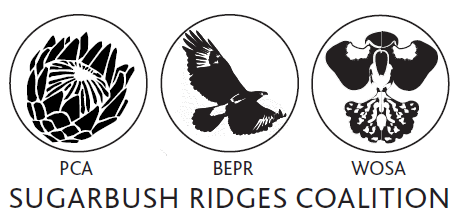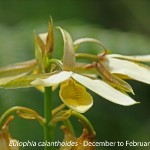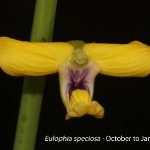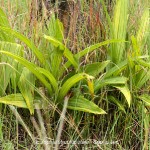Eulophia
The genus Eulophia is widespread throughout the tropical areas of the world ranging from south and central Africa, the Arabian Peninsula, India, China and the islands north of Australia including Thailand, Indonesia and Papua New Guinea. Some species are also found in Mexico and the southern parts of the United Sates. Originally the genus contained 212 species, subspecies and natural hybrids. A number of these were recently assigned to the genus Orthochilus. Currently Eulophia consists of 165 species, 10 subspecies and 2 natural hybrids. Of these 35 are found in South Africa. This a terrestrial species with the flowering stem borne next to the leaf bearing shoot. Most species have underground pseudobulbs and many go dormant during the dry, cooler winters. Some species carry their pseudubulbs above ground similar to the genus Cymbidium but with a thinner leaf texture and often very broad leaves. A few species are evergreen. The lip is three-lobed and often covered in crests, ridges or papillae. Flower colour ranges from white through cream to bright yellow, pink, brown and green or a mix of the colours including some with reddish tinges to the lip.
Credit
Martos, F., S.D. Johnson, C.I. Peter & B. Bytebier (2014). A molecular phylogeny reveals paraphyly of the large genus Eulophia (Orchidaceae): A case for the reinstatement of Orthochilus. Taxon 63(1): 9-23.
Johnson, S.D., Bytebier, B., Stärker, H. (2010). Orchids of South Africa: A field guide. Struik Nature, Cape Town, South Africa.
Eulophia speciosa
Description
Robust terrestrial, up to 900mm tall. Partly visible pseudobulbs sometimes evident. Leaves succulent, fully developed at flowering time, up to 650 mm long. Inflorescence lax, with 10-30 flowers. Sepals pale green, petals and lip yellow, lip side lobes with purple lines, crests deep yellow. Sepals reflexed, up to 13 mm long, lip 3-lobed, spur up to 3 mm long. Pollinated by carpenter bees. Syn: Eulophia austrooccidentalis, Eulophia leucantha, Eulophia wakefieldii.
Eulophia streptopetala
Description
Robust terrestrial with flowering stems that can grow up to 2.5m tall. The pseudobulb grows partially above the ground (much like a Cymbidium) and is up to 40 mm in diameter. The new growths develop from the base of the previous seasons matured pseudobulbs and the leaves are partially to fully developed when flowering. Leaves number between 4 and 9 and have a distinct ribbing appearance. The inflorescences, which grow next to the new growth with the developing pseudobulb, carries between 10 and 40 flowers. These are borne sequentially. Sepals are olive-green to green and are suffused with a reddish-brown. The petals are a chrome-yellow colour. No fragrance has been detected. The spur is 2mm in length.
For more information regarding the preservation of South Africa's wild Orchids or if you would like to get involved please email This email address is being protected from spambots. You need JavaScript enabled to view it. or complete this short form Contact Us and we will contact you.




